Site of former Sham Shui Po Camp and POW Camp [1927-????]
Primary tabs
1927. A camp for soldiers is built here on the recently reclaimed land. (See PWD report for 1927, quoted in the comments below.)
1941. 'C' Force (the Canadian troops) arrive in Hong Kong, and initially stay here.
1942-45. Used by the Japanese as a Prisoner of War camp to hold Allied soldiers.
Based on information from T and moddsey, and a 1949 map of the area, it looked as though the Barracks covered the area outlined in blue above. At that time the northwest and southwest boundaries of this area were the limits of the reclamation, and so faced the sea.
1965. The '65 map still shows parts of this area marked "WD65", ie belonging to the War Department. But the exact boundaries are not clear.
1979-1981. In the '65 map, the block adjacent to and northeast of the Police Station is shown as War Department Land. Between 1979-81 it was used as a camp to house Vietnamese refugees.
Some points to note:
- A. This road is named 'Camp Street', a reminder of the area's history.
- B. Commemorative Plaques and Trees in Sham Shui Po Park, remembering the POW camps, and those who suffered there. They are in the north corner of the park, shown by the circle on this park map:
- C. Sham Shui Po Police Station
- D. Site of Sham Shui Po ferry pier
- E. Site of Vietnamese Refugee Camp
Can anyone fill in what the area was used for in the other years?
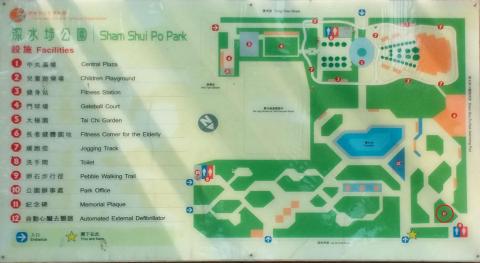
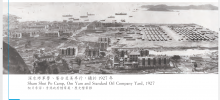
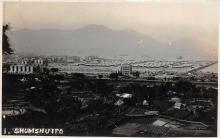
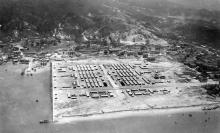

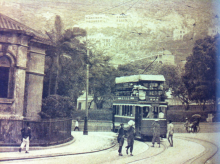
Comments
Sham Shui Po Barracks
After the Sham Shui Po Reclamation was completed the Military Authorites occupied a greater part of the site from 1927. Rows of single storey camp dwellings known as Hankow and Nanking Barracks were built. The military later acquired European type block of flats (Jubilee Buildings) on the foreshore for use as married quarters that overlooked the large parade grounds.
Sham Shui Po Barracks was bounded to the north by Fuk Wa St, to the east by Yen Chow St and to the west by Tonkin St. Camp St (northern entrance) provides the only remaining clue (apart from the plaque in Sham Shui Po Park) that there once stood military barracks in the district.
Sham Shui Po
The first place I lived at in HK in 1946 was Sham Shui Po Police Station. I remember little from that period however I went back many times in the next ten years. My mother continued to buy food frpm the Comprador about 20 yds down Lai Chi Kok Rd and I was dressed by Sun Kee Tailors again close to the Comprador, all the years I was in HK. My mother used to take the family to chose cloth in the road behind, Tai Nan St which had a nullah running down the middle. It was a centre for cloth stalls. I looked for the nullah in 2007 and it has long gone.
I do remember that the camp straddled the road and I believe there was a gate, again across the road.
I will upload some pictures of the Police Station. We had a flat on the first floor, on the corner of the building, junction Lai Chi Kok Rd and Yen Chow St. The picture of me with my trike shows the corner of the building and the building, now gone, across the road, below which were the Comprador and the tailors. I have added one picture which my Mother said was from the area, to show war damage.
regards
Stephen Roberts
Shum Shui Po
Hi Stephen: Are you thinking of the nullah which ran along the middle of Nam Cheong Street? I remember it too, with clothing shops sitting on top. They placed wooden planks across the floor or customers would fall into the nullah. It is probalby still there but under the roadway. Tai Nam Street did not have a nullah but along the centre it also had clothing shops. Across from the police station, there were, you will remember, many shops selling wickers or making wicker furniture. It was also the destination of the Number 2 bus coming out of the Star Ferry terminal.
SSP
SSP POW Camp
Re: SSP POW Camp
Hi there,
According to the photo and the sketch in the preview it appeared the camp stretched a block or two towards Castle Peak Road. I believe Fok Wah and/or Fok Wing Streets was the limit as there were pre-war shop houses along U Chau Street then. I remember I spotted and marked two such houses last year.
Best Regards,
T
Sham Shui Po District
Photos and maps of Sham Shui Po District can be found at this link:
http://hkclweb.hkpl.gov.hk/doc/internet/eng/18districts/ssp/map.html
Hankow Barracks
The memoirs of Valentine Frederick Loos Grevitt include the description of his arrival in Hong Kong in 1936:
After our fascinating initiation into the attractions of the eastern way of life we set sail on the final stage of our voyage to Hong Kong which we reached some time towards the end of April 1936. On our arrival those of us disembarking were wafted off to our various units. Ginger Lewis and I joined our Regiment at Hankow Barracks, Shamshuipo, Kowloon which was situated on the mainland known as the New Territories. Our barrack rooms were single story buildings, solidly built to withstand the perils of typhoons, spread over a wide area.
He goes on to describe life in Hong Kong at the time. The next section has an interesting description of his time in the International Settlement in Shanghai, when the Chinese and Japanese armies were still fighting for control of the city.
1927-1928 Photos of Sham Shui Po Camp
From the Northamption Museum Collection - 1927-1928 photos of Sham Shui Po Camp and motorised transport scenes of Faning can be viewed at:
http://www.flickr.com/search/?w=29031004@N06&q=hong%20kong
1934 photo of Sham Shui Po and barracks
A nice overview recently uploeaded to Flickr: http://flic.kr/p/9yfm5F
Completion Date - 26th April 1926
203. (iii) Erection of a Camp at Sham Shui Po: - The scheme comprised the erection and equipment of a large camp of wooden huts to accommodate two Infantry Battalions, with the necessary roads, storm water drainage, water supply, and lighting. About 140 huts were erected comprising the following :—Platoon Huts, Officers’ Quarters, Mess and Dining Rooms, Offices, Cook-houses, Latrines, Ablution Sheds, Guard Houses, Regimental Institutes, and various Stores.
With the exception of the Guard Houses and Food Stores which were built of brickwork, the huts were constructed on a wooden frame with Weatherboard sides, boarding and Malthoid roofs, and concrete floors.
The work also included the provision of all the necessary furniture and fittings, 900 Electric light and fan points, two telephones, and the formation of tennis courts.
The drainage work comprised three large open storm water channels of a special design constructed through the Camp, with twelve wooden bridges erected across them.
Sullage channels, pipe drains and gullies were laid round the Huts, etc., and trapped connections made.
A twentyone inch stormwater drain was constructed in Lai Chi Kok Road. A twelve inch stormwater channel was constructed in Apliu Street to drain pools, and an eighteen inch outfall sewer was extended in the street (un-named) parallel to and North-West of Yen Chow Street.
The arrival of large numbers of troops in the Colony made acceleration in the construction of the Camp of the greatest importance. The two principal Contracts for the erection of the Huts by The Hong Kong Excavation, Pile Driving and Construction Company, Ltd., and Messrs. Kin Lee & Co, were signed on the 1st and 2nd of March respectively, the plans having been prepared and tenders obtained in the course of about one week previous to the former date.
These Contracts were completed by the 17th and 7th of April respectively, and all the furniture and, fittings were installed by the 26th idem, the whole of the Camp being thus equipped and ready for occupation in less than two months from the commencement of its construction.
The Regimental Institutes were erected and completed at somewhat later dates.
1926 PWD Report: Source[Update: As Moddsey notes below, this information comes from item 203 of the 1927 PWD Report, not 1926 as mentioned above.]
Re: Completion Date of Sham Shui Po Camp
The PWD Report listed above should be for 1927 and not 1926 as newspaper reports in April 1927 confirm the hurried completion of the Camp.
Thanks for the correction. I
Thanks for the correction. I confirm the above information came from the PWD's annual report for 1927, and I've updated the completion date at the top of the page.